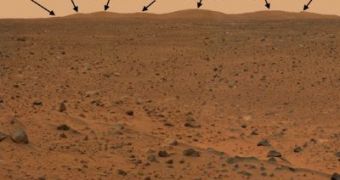NASA's Mars Exploration Rover Spirit has confronted a Martian version of "things being not quite what they seem". From Spirit's distant landing site out on the plains of Gusev Crater, the highest peak in the "Columbia Hills" appeared to be "Husband Hill."
But looks can be deceiving. In this image of the "Columbia Hills" in Gusev Crater on Mars, "Husband Hill" is 3.1 kilometers distant; "McCool Hill" is 4.2 kilometers away. From this vantage point, "Husband Hill" appears taller than "McCool Hill" because it is closer. Spirit took this mosaic of images with the panoramic camera at the beginning of February, 2004, less than a month after landing on Mars. Click for large image.
After making a trek to the "Columbia Hills," Spirit has been traversing and studying slopes, rocks, and sand deposits there for more than a year. The new measurements from Spirit show that "McCool Hill" is in fact about 26 meters taller than its neighbor, "Husband Hill." And, indeed, digital maps created from orbital images tell a similar story. At first, "McCool Hill," partly blocked from view, appeared smaller.
The revised estimates illustrate the importance of location as well as number of measurements. Generally speaking, the more measurements, the better. Even then, there's room for error.
For instance, using the 27 Earth-orbiting satellites in the Global Positioning System (GPS), a team of scientists measured the summit of Mt. Everest at 8,850 meters above sea level - plus or minus 2 meters. What's difficult to pinpoint on Earth is even more challenging on Mars - there are only three working orbiters above Mars, and no synchronized GPS.
Image credit: NASA/JPL-Caltech/Cornell

 14 DAY TRIAL //
14 DAY TRIAL //